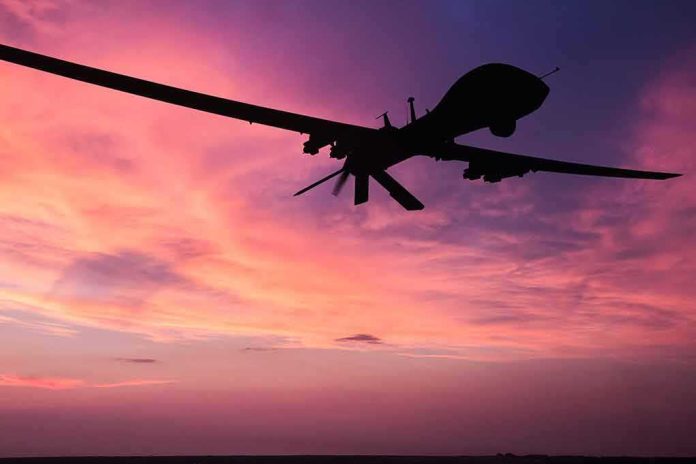
Over 350 unauthorized drone incursions have been documented at U.S. military bases this year, yet our defenses remain dangerously inadequate as Congress demands immediate answers about why our most sensitive facilities remain vulnerable to potentially catastrophic aerial threats.
Key Takeaways
- House Republicans have documented over 350 unauthorized drone intrusions at more than 100 U.S. military bases in 2024, highlighting critical security vulnerabilities.
- Current regulations hamstring base commanders by requiring confirmation of “hostile intent” before responding to drone threats—a dangerously outdated approach in an era of fast-moving drone warfare.
- Only certain federal agencies (Defense, Energy, Justice, Homeland Security) currently have legal authority to counter drone threats, leaving critical infrastructure exposed.
- Modern drone warfare capabilities, as demonstrated in Ukraine and the Middle East, have transformed drones from surveillance tools into lethal weapons capable of precision strikes.
- The Military and Foreign Affairs Subcommittee has demanded comprehensive documentation on counter-drone policies and incident reports by July 10, 2025.
America’s Military Bases Under Drone Siege
The alarming frequency of drone incursions over America’s military installations has reached crisis levels, with House Republicans documenting over 350 unauthorized drone intrusions at more than 100 bases this year alone. Representative William Timmons (R-SC) and fellow Republicans from the Military and Foreign Affairs Subcommittee have launched a formal investigation, sending demand letters to the Departments of Defense, Transportation, and Justice. The congressional inquiry comes after disturbing incidents including drones that surveilled Langley Air Force Base in Virginia for over two weeks in December 2023, demonstrating a persistent and coordinated effort to gather intelligence on one of our most sensitive military facilities.
“Recent high-profile incursions near sensitive military facilities, power infrastructure, and public events suggest that the current framework for domestic counter-drone operations remains fragmented and, in some cases, insufficiently agile to meet evolving threats,” lawmakers stated in their official correspondence to federal agencies.
Outdated Rules Hamstring Military Response
The bureaucratic nightmare facing our military defenders becomes clear when examining the current protocol for responding to drone threats. Base commanders must confirm “hostile intent” before taking countermeasures—an absurd requirement in an age where AI-enabled drones can deliver lethal payloads within seconds of detection. This outdated approach has created a situation where unidentified drones can freely monitor our most sensitive installations, collecting intelligence that could be transmitted to foreign adversaries. The current regulatory framework leaves our nation’s most critical assets vulnerable while federal agencies debate jurisdictional boundaries and proper response protocols.
“This is a rapidly evolving threat that requires a unified and proactive response,” stated the congressional letter addressing the alarming increase in drone incursions.
Lessons from Ukraine: The Growing Drone Threat
The Russian invasion of Ukraine has served as a stark demonstration of how rapidly drone warfare has evolved and why America’s current defensive posture is woefully inadequate. Low-cost, GPS-guided “kamikaze drones” like the Iranian-made Shahed-136 have proven devastatingly effective on modern battlefields. These weapons systems, which were once the exclusive domain of major military powers, have become increasingly accessible to non-state actors and even sophisticated criminal organizations. This democratization of aerial attack capabilities means that the hundreds of drone incursions already documented could represent reconnaissance for future attacks or deliberate testing of our defensive capabilities and response times.
“Capabilities for detecting and mitigating UAS may implicate federal criminal laws relating to surveillance, accessing or damaging computers, and damage to an aircraft,” according to an advisory guidance document highlighting the legal complications in responding to drone threats.
A Fragmented Defense System
The current counter-drone defense system in the United States is characterized by jurisdictional confusion and technological inconsistency. Only a handful of federal agencies—Defense, Energy, Justice, and Homeland Security—have legal authority to interfere with drone operations, leaving massive security gaps across our critical infrastructure. Advanced counter-UAS systems, including electronic warfare capabilities and laser defense systems, are unevenly deployed across U.S. military installations. This patchwork approach to national security has created vulnerabilities that adversaries can exploit, especially when our legal framework prioritizes bureaucratic protocols over the immediate neutralization of potential threats.
“The Preventing Emerging Threats Act of 2018 grants the Department of Homeland Security statutory authority to counter credible threats from unmanned aircraft systems (UAS) to the safety or security of a covered facility or asset,” states a Department of Homeland Security document that outlines some of the limited legal authorities currently available.
The congressional demand for documentation by July 10th represents a crucial first step in addressing this national security vulnerability. Republicans have specifically requested interagency policies, incident reports dating back to January 2022, and plans for establishing a joint task force to coordinate defense efforts. President Trump’s administration will need to move quickly to implement comprehensive counter-drone capabilities across all sensitive installations before these reconnaissance missions transform into something far more dangerous. The time for action is now—our enemies are already flying in our skies, mapping our vulnerabilities, and preparing for potential attacks while our defenders remain legally handcuffed from responding effectively.










